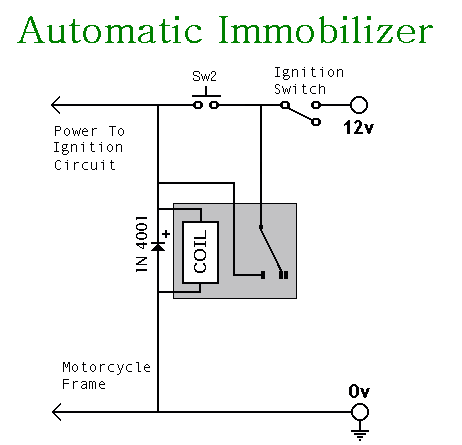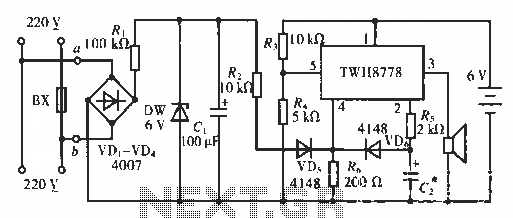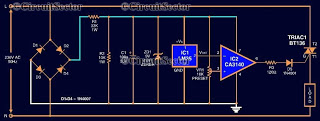
Motorcycle Alarm PCB

This circuit includes an intermittent siren output with automatic reset functionality. It can be activated manually via a key switch or a concealed switch, or it can be configured to activate automatically when the ignition is turned off. By incorporating external relays, the circuit can immobilize the motorcycle, flash lights, and more. Multiple normally-open switches can be utilized. Tilt switches can be installed to activate when the steering is moved or when the motorcycle is lifted off its side stand or pushed off its center stand. Micro-switches can be used to secure removable panels and pannier lids. Once triggered, the siren's on/off cycling rate is controlled by resistors R9 and capacitor C5; increasing C5 slows the cycle, while decreasing R9 speeds it up. The siren will sound as long as at least one switch remains closed. The alarm will reset approximately thirty seconds after all switches are opened, with the reset duration adjustable by changing resistor R6 and/or capacitor C4. The circuit is intended for use with an electronic siren drawing 300 to 400 mA. It is typically not advisable to use the motorcycle's horn due to its accessibility for disconnection, but if the horn is chosen, a relay rated for higher current must be used. The circuit board and switches require protection from environmental conditions, as moisture can lead to malfunctions. The components are arranged flat on the board, while those connected between close or adjacent tracks are mounted upright. Connections are made with bare copper wire on the component side. The support material for this alarm includes a comprehensive guide for circuit board construction, a parts list, and a complete circuit description. A 1-amp in-line fuse should be connected as close as possible to the power source to protect the wiring, not the alarm. The installation specifics will vary based on the motorcycle model, and further assistance cannot be provided in this regard. The quiescent (standby) current of the circuit is nearly zero, preventing battery drain. For manual operation, a key switch or hidden switch should be connected to the "off/set" terminals. For automatic operation, connect a wire from the ignition circuit to the "ignit" terminal, allowing the alarm to activate whenever the ignition is turned off. This ignition wire is not protected by the 1-amp inline fuse, so if the wire run is lengthy, it should have its own 1-amp fuse as close to the source as possible. Before installation, one must consider the safety implications of potential failures and the legal ramifications of installing a device that may cause an accident. If installation proceeds, high-quality materials and workmanship are essential. The relay must be adequately rated to handle the ignition system's current and should be designed for automotive use to ensure durability against environmental factors. When the ignition is turned on again, the relay will not energize, maintaining a break in the ignition circuit until switch Sw2 is pressed. The relay then latches itself on using its own contacts, which also reconnect the ignition circuit. The design offers several advantages, including automatic operation upon ignition turn-off, zero current draw from the battery when the ignition is off, and deactivation requiring both the ignition key and knowledge of the push-switch location. For enhanced security, switch Sw2 could be key-operated.This circuit features an intermittent siren output and automatic reset. It can be operated manually using a key-switch or a hidden switch; but it can also be wired to set itself automatically when you turn-off the ignition. By adding external relays you can immobilize the bike, flash the lights etc. Any number of normally-open switches may be used . Fit "tilt" switches that close when the steering is moved or when the bike is lifted off its side-stand or pushed forward off its centre-stand. Use micro-switches to protect removable panels and the lids of panniers etc. Once activated, the rate at which the siren switches on and off is controlled by R9 & C5. For example - increasing the value of C5 will slow it down, while reducing the value of R9 will make it faster.
While at least one switch remains closed the siren will sound. About thirty seconds after all of the switches have been opened, the alarm will reset. How long it takes to switch off depends on the characteristics of the actual components used. You can adjust the time to suit your requirements by changing the value of R6 and/or C4. The circuit is designed to use an electronic Siren drawing 300 to 400mA. It`s not usually a good idea to use the bike`s own Horn because it can be easily located and disconnected. However, if you choose to use the Horn, remember that the alarm relay is too small to carry the necessary current.
Connect the coil of a suitably rated relay to the "Siren" output. This can then be used to sound the Horn, flash the lights etc. The circuit board and switches must be protected from the elements. Dampness or condensation will cause malfunction. The components are all drawn lying flat on the board - but those connected between close or adjacent tracks are mounted standing upright. The links are bare copper wire on the component side. The Support Material for this alarm includes a detailed guide to the construction of the circuit-board, a parts list, a complete circuit description and more.
Connect a 1-amp in-line fuse AS CLOSE AS POSSIBLE to your power source. This is VERY IMPORTANT. The fuse is there to protect the wiring - not the alarm. Exactly how the system is fitted will depend on the make of your particular machine - so I`m unable to provide any further help or advice in this regard. The quiescent (standby) current of the circuit is virtually zero - so there is no drain on the battery.
If you want to operate the alarm manually use a key-switch or a hidden switch connected to the "off/set" terminals. For automatic operation connect a wire from the ignition circuit to the "ignit" terminal. Then every time you turn-off the ignition - the alarm will set itself. Remember that this wire from the ignition switch is not protected by your 1-amp inline fuse. So unless its run is very short - fit the wire with its own 1-amp fuse as close as possible to its source.
Before fitting this or any other immobilizer to your bike, carefully consider both the safety implications of its possible failure - and the legal consequences of installing a device that could cause an accident. If you decide to proceed, you will need to use the highest standard of materials and workmanship. Remember that the relay MUST be large enough to handle the current required by your ignition system. Choose one specifically designed for automobiles - it will be protected against the elements and will give the best long-term reliability.
You don`t want it to let you down on a cold wet night - or worse still - in fast moving traffic! Please note that I am UNABLE to help any further with either the choice of a suitable relay - or with advice on its installation. When the ignition is switched on again the relay will not energize. The bike`s ignition circuit will remain broken until you press Sw2. The relay then uses its own contacts to latch itself on. The same contacts complete the connection to the ignition circuit. The design has a number of advantages. It operates automatically when you turn-off the ignition - so there`s no need to remember to activate it.
The relay uses no current while the ignition is off - so there`s no drain on the battery. To de-activate it you`ll need to have the ignition key and you`ll need to know the whereabouts of the push-switch. For extra security Sw2 could be key-operated. 🔗 External reference
While at least one switch remains closed the siren will sound. About thirty seconds after all of the switches have been opened, the alarm will reset. How long it takes to switch off depends on the characteristics of the actual components used. You can adjust the time to suit your requirements by changing the value of R6 and/or C4. The circuit is designed to use an electronic Siren drawing 300 to 400mA. It`s not usually a good idea to use the bike`s own Horn because it can be easily located and disconnected. However, if you choose to use the Horn, remember that the alarm relay is too small to carry the necessary current.
Connect the coil of a suitably rated relay to the "Siren" output. This can then be used to sound the Horn, flash the lights etc. The circuit board and switches must be protected from the elements. Dampness or condensation will cause malfunction. The components are all drawn lying flat on the board - but those connected between close or adjacent tracks are mounted standing upright. The links are bare copper wire on the component side. The Support Material for this alarm includes a detailed guide to the construction of the circuit-board, a parts list, a complete circuit description and more.
Connect a 1-amp in-line fuse AS CLOSE AS POSSIBLE to your power source. This is VERY IMPORTANT. The fuse is there to protect the wiring - not the alarm. Exactly how the system is fitted will depend on the make of your particular machine - so I`m unable to provide any further help or advice in this regard. The quiescent (standby) current of the circuit is virtually zero - so there is no drain on the battery.
If you want to operate the alarm manually use a key-switch or a hidden switch connected to the "off/set" terminals. For automatic operation connect a wire from the ignition circuit to the "ignit" terminal. Then every time you turn-off the ignition - the alarm will set itself. Remember that this wire from the ignition switch is not protected by your 1-amp inline fuse. So unless its run is very short - fit the wire with its own 1-amp fuse as close as possible to its source.
Before fitting this or any other immobilizer to your bike, carefully consider both the safety implications of its possible failure - and the legal consequences of installing a device that could cause an accident. If you decide to proceed, you will need to use the highest standard of materials and workmanship. Remember that the relay MUST be large enough to handle the current required by your ignition system. Choose one specifically designed for automobiles - it will be protected against the elements and will give the best long-term reliability.
You don`t want it to let you down on a cold wet night - or worse still - in fast moving traffic! Please note that I am UNABLE to help any further with either the choice of a suitable relay - or with advice on its installation. When the ignition is switched on again the relay will not energize. The bike`s ignition circuit will remain broken until you press Sw2. The relay then uses its own contacts to latch itself on. The same contacts complete the connection to the ignition circuit. The design has a number of advantages. It operates automatically when you turn-off the ignition - so there`s no need to remember to activate it.
The relay uses no current while the ignition is off - so there`s no drain on the battery. To de-activate it you`ll need to have the ignition key and you`ll need to know the whereabouts of the push-switch. For extra security Sw2 could be key-operated. 🔗 External reference





